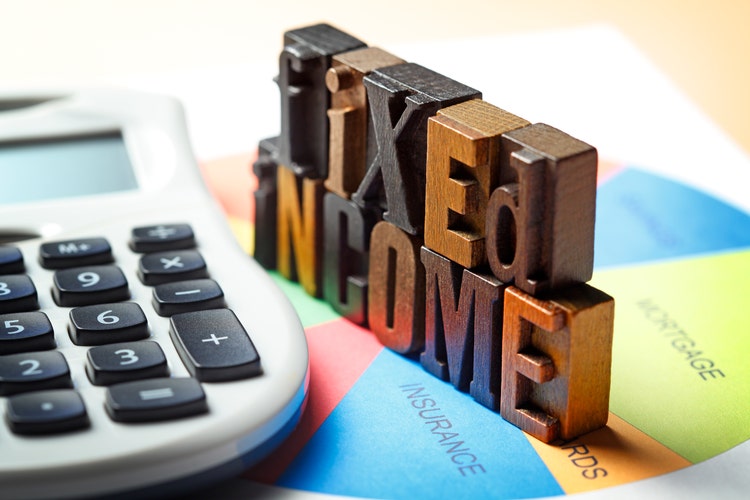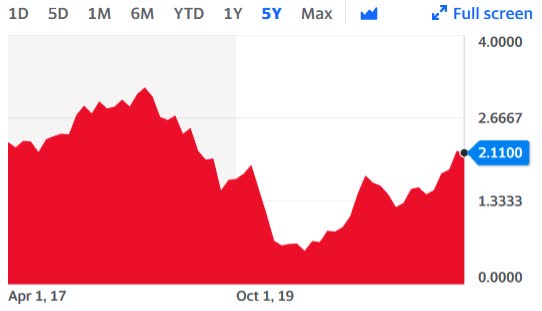
DNY59/iStock via Getty Images
At the time of this writing stock markets are in a correction due to a host of pressures and fears, such as inflation, rising interest rates and the uncertainties caused by the Russia-Ukraine war. While the war certainly weighs on investor’s minds (we acknowledge the great human tragedy but will put this aside for this article about investing) it is inflation and interest rates which are more important to the markets. The 10-year Treasury yield is now at 2.11%, the highest since June 2019, see chart below. Inflation and oil prices have been moving ever higher, and markets are waiting to see if inflation falls back to a more manageable ongoing number, even if higher than in the past.

10 year Treasury Yield (Yahoo Finance)
The most noticeable area of the correction is in the technology and “fad stock” sector, where the Nasdaq index is down about 20% and widely held favorites like Tesla (should an auto company, no matter how great, ever be worth $1.3 trillion?), Facebook and Netflix are down some 35%-45%. Pandemic favorite Zoom Video is down about 50%. Large cap stocks are in correction territory, down about 12%. At the same time fixed income indexes have fallen, with the high yield bond index down 7-8% (HYG), the investment grade bond index down 9% (LQD), and the preferred stock index down 10-11% (PFF). Many popular fixed income close end funds have fallen even more sharply, such as PIMCOs Dynamic Income Fund down (PDI) 14-15% and Doubline Opportunistic Credit Fund (DBL) down 10%.
We believe that the current market correction has created bargain opportunities in high yield fixed income and presents an opportunity to lock in a high yielding portfolio that will be well positioned to manage through rising rates that may continue in response to higher inflation. There are two ways we manage fixed income portfolios that protect against rising rates: (1) invest in short to medium term duration instruments and (2) invest in fixed income securities that offer a floating-rate feature. The other key ingredient is to select issuers that are of solid credit quality within the context of high yield fixed income investing. Investment Grade rated fixed income in aggregate will always be of higher credit quality than high yield fixed income, but with proper due diligence and portfolio diversification, the risk/reward in high yield is typically more attractive.
When we talk about high yield fixed income, we mean a wider range of investments than simply high yield bonds. Here are the key asset classes that comprise our high yield income portfolios, providing the diversity necessary to greatly lower the risk of a possible bad outcome in any one holding:
1) Traditional high yield bonds sold on the bond market
2) Exchange traded bonds, typically sold in $25 increments on the stock exchange and are often issued by smaller companies
3) Preferred stock, often providing a floating rate or fixed-to-floating rate feature which provides good rising rates protection
4) Closed end funds, which is a broad universe of funds that offers investor access to segments of fixed income only available to institutional investors, such as bank loan funds and mortgage related assets; these funds are often attractive since they trade at discounts
Portfolios can be built with a target yield in mind depending on the yield goals or income needs of the portfolio. Here are some of the opportunities we are investing for clients now. (Please note that these are for discussion purposes only and should not be considered recommendations, as each investor’s needs are different based on a wide range of factors. High yield fixed income is not appropriate for all investors. The information provided below is simply a broad summary of the investments and there are many more details that would need to be considered to fully understand and consider the investment):
High Yield Bonds: Delek Logistics Partners 6.75% of May 15, 2025, trading around par to yield 6.75%. Delek (DKL) owns and operates logistics and marketing assets for crude oil, and intermediate and refined products in the United States. Performance has been strong with 9% EBITDA growth in 2021 and modest leverage in the low-3x range. The three year maturity is attractive.
Exchange Traded Bonds: Eagle Point Income Company bonds, 5.00% of Oct 31, 2026, trading under ticker symbol EICA. The issue is trading at about $23.46, a 6% discount to par ($25), therefore the yield-to-maturity is 6.6% (The bonds are technically classified as Term Preferred Stock but act very similar to a bond with a 2026 maturity date). The issuing company is a closed-end fund that invests in the debt tranches of CLOs. By regulation, asset coverage must be maintained at a 200% minimum providing excellent protection to investors. Current asset coverage is running at 300%.
Preferred Stock: Dynex Capital, 6.9% fixed-to-floating cumulative preferred stock series C (DX.PC). The issue is fixed at 6.9% until 4/15/2025 when it will convert to a floating rate issue at LIBOR+5.45%. The issue is currently trading at $24.50, a 2% discount to par ($25). The current yield is 7.00% and if the issue gets called in April 2025, it would result in an 8.15% yield (no way to know if this will be called). If it does not get called, investors enjoy a floating rate that protects against rising rates. Dynex (DX) is a mortgage REIT with 98% of its portfolio in Agency securities, which are effectively government backed and thus considered nearly risk free. While the stock price can fluctuate based on a variety of factors, the preferred stock enjoys preference on its fixed dividend so the stock price does not matter much to preferred stock investors. DX managed through the pandemic just fine and its stock price is higher now than pre-pandemic.
Closed End Funds: BNY Mellon Alcentra Global Credit Income 2024 Target Term Fund (DCF). This closed end fund is in a unique category of funds, as it has a mandated liquidation date of Dec 1, 2024. The fund invests in a variety of income asset classes, with bank loans comprising 40%, and structured credit and high yield the remainder. The fund is trading at $8.26/unit which is a 5% discount to net asset value; for most of 2021 the fund traded at a premium but sank during this correction. In addition to its yield of 7.3% (which is covered 100% by net investment based on the latest financial statements), investors will earn back any discount to net asset value upon fund liquidation in December 2024, boosting yields further.
In our experience these “windows of opportunity” to lock in higher yields are limited to a few months at a time that present themselves every couple of years, and sometimes less. While we cannot predict the future course of the markets, we expect that once the Fed makes some moves and the Russia/Ukraine situation evolves towards some kind of resolution, many of these fixed income issues will trade back to their 2021 levels or even higher — especially those that have maturities under five years or other features that protect against rising rates.
Please be aware that the author holds the highlighted investments in personal and client accounts, and may have added/will add to positions at any time prior to or following the publication of this article.
It is important to note that high yield fixed income investments such as the ones highlighted in this article are by definition not “investment grade” and are thus only appropriate for investors willing to accept a higher fixed income risk profile. Only consider High Yield bonds and similar investments only as part of a broader investment portfolio allocation to various assets of all risk profiles.
Please see the Downtown Investment Advisory profile page for important disclaimer language, which is an integral part of this article.

